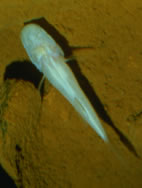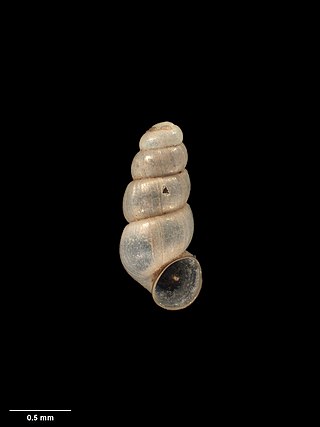
Powelliphanta is a genus of large, air-breathing land snails, pulmonate gastropods in the family Rhytididae, found only in New Zealand. They are carnivorous, eating invertebrates, mostly native earthworms. Often restricted to very small areas of moist forest, they are prey to introduced mammalian predators, and many species are threatened or endangered.

The New Zealand greater short-tailed bat is one of two species of New Zealand short-tailed bats, a family (Mystacinidae) unique to New Zealand. Larger than the New Zealand lesser short-tailed bat, there have been no confirmed sightings of this species since 1965 and it is considered to be critically endangered, if not extinct. In prehistoric times it lived in the North and South Islands but by the time of European arrival was restricted to small islands near Stewart Island/Rakiura. A rat invasion of Taukihepa/Big South Cape Island in 1963 was thought to have led to the species' extinction, however, recent surveys have raised hopes that the species may still exist.

The New Zealand mud snail is a species of very small freshwater snail with a gill and an operculum. This aquatic gastropod mollusk is in the family Tateidae.

The Alabama cavefish is a critically endangered species of amblyopsid cavefish found only in underground pools in Key Cave, located in northwestern Alabama, United States in the Key Cave National Wildlife Refuge. It was discovered underneath a colony of gray bats in 1967 by researchers Robert A. Kuehne and John E. Cooper and scientifically described in 1974.

The lowland longjaw galaxias is a galaxiid of the genus Galaxias, found only in the South Island of New Zealand, in the Kauru River, a tributary of the Kakanui River in north Otago, and in parts of the upper Waitaki catchment. It grows to a length of up to 7 cm.
Chiltonia is a genus of amphipod crustaceans endemic to New Zealand. Four species are known, three of which live in fresh waters. They were first discovered by Charles Chilton in 1898 and the genus Chiltonia was erected the following year by T. R. R. Stebbing in Chilton's honour.

Beddomeia hallae, also known as Buttons Rivulet hydrobiid snail, is a species of small freshwater snail that is endemic to Australia. The species is an aquatic operculate gastropod mollusk in the family Hydrobiidae. Beddomeia hallae belongs to the genus Beddomeia, which is the largest group in the family Hydrobiidae, consisting of 47 species. In the Threatened Species Protection Act 1995, this species is one of the 37 Beddomeia species listed as endangered, however, on the International Union for Conservation of Nature Red List, the species is listed as vulnerable. Found in Tasmania, in the streams of Buttons Rivulet and Castra Rivulet, Beddomeia hallae is sighted in its natural habitat amongst wood, leaves and under stones. Nonetheless, the Beddomeia species including Beddomeia hallae are geographically isolated, existing within restricted ranges.
Beddomeia launcestonensis is a species of very small freshwater snail that has a gill and an operculum, an aquatic operculate gastropod mollusk in the family Hydrobiidae. This species is endemic to Australia.

The New Zealand Threat Classification System is used by the Department of Conservation to assess conservation priorities of species in New Zealand.

Placostylus ambagiosus is a species of flax snail, a large air-breathing land snail, a terrestrial pulmonate gastropod mollusc in the family Bothriembryontidae.
Garrick's catshark is a species of shark in the family Scyliorhinidae found in the waters of New Zealand. Its natural habitat is the open seas. The new deep-water catshark, Apristurus garricki, is described from the waters of northern New Zealand. It is named in honour of Jack Garrick.

Catapyrgus sororius is a critically endangered species of fresh water snail endemic to New Zealand.

Hadopyrgus ngataana is a tiny, transparent, and critically endangered freshwater snail, found only in a single stream in a cave in New Zealand.

Hadopyrgus rawhiti is a critically endangered species of freshwater snail native to New Zealand.
Opacuincola cervicesmadentes is a critically endangered species of freshwater snail endemic to New Zealand.
Opacuincola dulcinella is a critically endangered species of freshwater snail endemic to New Zealand.

Opacuincola eduardstraussi is a critically endangered species of fresh water snail native to New Zealand.
Potamopyrgus acus is a critically endangered species of fresh water snail native to New Zealand.
Hadopyrgus is a genus of white or transparent freshwater snails found only in New Zealand. They are micromolluscs, just a few millimetres long, in the gastropod family Tateidae. Hadopyrgus species are subterranean – living in caves, underground aquifers, or deep in river gravels – and so were named from the Greek hades (underworld) and pyrgos (tower). They can have quite restricted ranges: Hadopyrgus ngataana, for example, has been found in just one pool, in a stream flowing through a single cave.

Potamopyrgus oppidanus is a species of freshwater gastropod mollusk in the family Tateidae. It is endemic to New Zealand where it is found only in one area in the town belt of Wellington.













